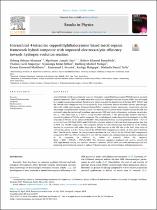| dc.description.abstract | A novel hybrid-hybrid nanocomposite based on 4-tetranitro copper(II)phthalocyanine (TNCuPc) grown on metal
organic frameworks (MOF) as a noble metal-free catalyst for hydrogen evolution reaction (HER) was developed
by a simple impregnation method. The structure, surface area and the morphology of the bare MOF, TNCuPc and
the TNCuPc/MOF composite were characterized by X-ray diffraction, Fourier transform infrared spectroscopy,
ultraviolet-visible spectroscopy, Brunauer-Emmet-Teller, scanning electron microscopy, transmission electron
microscopy and simultaneous thermal analysis. The electrocatalytic activity of the samples towards the HER was
evaluated using electrochemical impedance spectroscopy (EIS) and cyclic voltammetry, exchange current density, i0, Tafel slope value, b, as well as charge transfer coefficient, α. The spectroscopic analyses indicated a
successful synthesis of TNCuPc and its composite. The morphological results showed the development of rod-like
structures of TNCuPc on the surface of the MOF. The composite exhibited an onset potential of about −0.713 V
vs. Ag/AgCl in 0.1 M TBAP/DMSO and 0.3 M H2SO4 solutions, which is 44 mV and 9 mV more positive than that
of MOF and TNCuPc respectively. The composite showed the rate determining step (RDS) to be the Volmer
reaction in conjunction with either Heyrovsky or Tafel reaction as the RDS due to the Tafel slope value of
147 mV/dec and an α of 0.4. The i0 value of the TNCuPc/MOF composite was about 1.6 times that of the bare
MOF. The EIS results showed the charge transfer resistance (Rct) of 12.6 kΩ for the TNCuPc/MOF composite as
compared to MOF and TNCuPc values of 41 and 18.6 kΩ, respectively, demonstrating an excellent conductivity
of the composite. In addition, Rct values of materials follow the sequence,
blank < MOF < TNCuPc < TNCuPc/MOF. The fabricated composite displayed high activity towards the
HER, high thermal stability, and excellent tolerance. Therefore, TNCuPc/MOF non-noble electrocatalyst can be a
promising electrochemical catalyst to replace Pt-based catalysts for electrochemical hydrogen production. | en_US |

